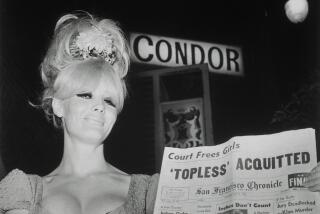Classic Hollywood: Pam Grier blazed the trail for women action heroes
Pam Grier was a struggling UCLA film student in the late 1960s when she got an intriguing offer.
To pay for school she was working part time as a switchboard operator at a casting agency. An agent told her that producer Roger Corman was looking for an actress. Corman’s New World Pictures was one of Hollywood’s chief suppliers of “B” movies — mostly action-packed genre films.
For the record:
5:53 a.m. April 26, 2024An earlier version of this article said that Pam Grier was a USC film student. She attended UCLA.
The agent told her Corman was “looking for someone who is kind of in-your-face.” And the agent thought Grier had just the right look for that — “raw, unpolished and natural” was what he told her.
But Grier was skeptical. “I’m a student — a starving student — with one skirt and one blouse and an Afro in Hollywood,” Grier recalled. “I don’t think I’ll do well.”
Because she didn’t know anything about acting, Grier worried that she would lose her focus and lose out on film school if she went into acting. So did her mother. “You can be fired because you never acted before,” her mother told her. “You want to go to film school.” “I said, ‘Mom, you’re right, I’ll stay focused.’”
But the $600 Corman was offering was tempting and she met with the producer-director. “When I talked to him I said, ‘Roger, I can’t be fired. I don’t know what to do. You have to talk to my mom to make sure you going to take care of me and don’t fire me. I can’t just go off into this and think I am going to be a movie star.”
She was wrong.
Grier became not only a movie star but a breakthrough performer, both as a female action star and as an African American actress. Statuesque, tough, funny and sexy, Grier came to fame in the 1970s in such blaxploitation classics as “Coffy,” “Sheba, Baby” and “Foxy Brown” and gave new meaning to femme fatale as she took down the bad guys
Grier’s films are prominently featured on the streaming service Brown Sugar, which began last November. There are 100 films from the era on the site, including “Shaft” starring Richard Roundtree, “The Mack” with Max Julian, “Superfly” starring Ron O’Neal and numerous films starring NFL stars-turned-actors Jim Brown and Fred Williamson. Even in this crowd, Grier stands out — she was like no one else.
“Does anyone personify the word ‘icon’ more than Pam Grier?,” said Jonathan Katz, CEO of the African American Network Bounce TV, which owns Brown Sugar. “She blazed a trail not just for African American actresses but for all actresses, showing Hollywood that a strong woman would open and carry movies as the lead. Pam’s entire body of work still influences filmmakers and American culture to this day.”
After moving from her home in Denver to Los Angeles in the late 1960s, she decided to study directing at UCLA film school.
“I started meeting these films students … there were no gender issues,” said Grier, 67, by phone from her rural ranch south of Denver. “It was the time of women’s liberation — Gloria Steinem and equal pay and equality. I thought, ‘I love this. This is why I am here. I want to get into film school.’ ”
But when her Hollywood career took a surprise turn, Grier started preparing. Corman gave her a copy of landmark acting teacher Konstantin Stanislavski’s book “An Actor Prepares.” So Grier became a Method actress of the blaxploitation films.
“I couldn’t get fired for wearing a wet T-shirt improperly,” she said, laughing. “I learned how to wear a wet T-shirt. I learned how to roll a cigarette. I learned how to really slap someone. I learned the essence of what Method acting was and would later see that in Robert De Niro, Al Pacino and Gene Hackman movies.”
(Years later, she would work with De Niro in 1997’s “Jackie Brown,” Quentin Tarantino’s celebration of her quintessential low-budget action films.)
Of course, everyone on the set of her first movie, Jack Hill’s 1971 prison flick “The Big Doll House,” filmed in the Philippines, thought she was crazy. The actresses told her just learn her lines in the morning.
“I said, ‘No. I’m going to learn them tonight. I am going to study.’ I said, ‘We’re in prison. I’m not going to shave my legs.’ They said, ‘Oh, you have to shave your legs or you’ll never get a date. I said, ‘I’m not worried about dating. I’m in prison!”
She said her determination to humanize her characters is one reason her films are still so entertaining today. “It just made the movies more real and more interesting,” she said. “[The audiences] responded to how I worked. I was trying to bring as much to the roles as the audience could comprehend.”
Though she lives in rural Colorado, Grier continues to work in Hollywood. She recently finished an indie film, “Rose,” with Cybill Shepherd and James Brolin and a comedy “Grandmother’s Murder Club,” with the late Florence Henderson.
She’s also written screenplays she wants to direct, noting, “I just want the opportunity to tell a story about the African American community and the women’s movement — to not preach and pontificate, but at least allow the audience to understand what it was like to live through and survive.” (In her 2010 memoir, “Foxy: My Life in Three Acts,” Grier revealed that she had been sexually assaulted twice while growing up.)
Her mother was a nurse and a community activist. “An ambulance never came to our neighborhood, so she would often fix someone’s leg or tooth or bump on the head in the kitchen. She was always tending to someone.”
More to Read
Only good movies
Get the Indie Focus newsletter, Mark Olsen's weekly guide to the world of cinema.
You may occasionally receive promotional content from the Los Angeles Times.







